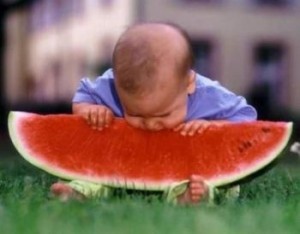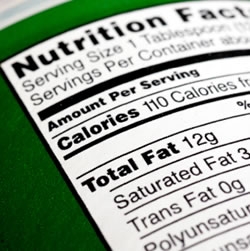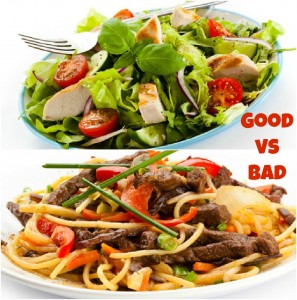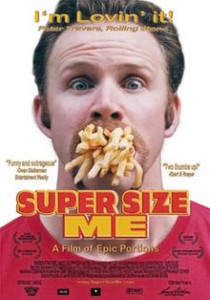
It’s downright scary just how quickly our population has gained weight – expanding from an obesity prevalence of less than 20 percent in the mid 1980s to over 35 percent today. Experts have spent a great deal of time studying the problem, and have come up with a number of factors that have contributed to this rapid rise in body fat among the Western populace.
We’ve discussed many of the contributing factors, including the ubiquity of sugar and high-fructose corn syrup in processed foods, the fact that processed and fast foods make up such a significant portion of the Western diet, and the decrease in activity. One thing we haven’t discussed much, however, is portion sizes and how much they’ve grown over the past few decades.
Calories and Over-Fueling
Most people are just eating way too much food- which is exhausting to the entire digestive system, and is simply way too much matter to give the body to deal with.
While calories aren’t the be-all and end-all in weight loss/weight gain, they do matter. Calories aren’t quite as simple as most diets tell you they are, however. A calorie (technically a kilocalorie, but it’s been shortened to calorie) is merely a measure of heat energy. As a thermodynamic measure, calories measures tell you how much energy some type of fuel provides a machine. In the case of food calories, we are equating foods for energy and our bodies with machines. It’s an overly simplistic view of the human body, and the emphasis on calories has misled a population desperate to lose weight into believing that calorie counts of foods are the single most important aspect of the foods when you’re trying to control your weight.
Why is that overly simplistic? Because if you have 200 calories of Snickers bar sitting in front of you, it’s going to provide your body with very different things than 200 calories of dark, leafy greens. Your body is not a simple mechanical machine. Instead, it is a complex biological mechanism that will respond to and utilize the Snickers calories quite differently than the leafy green calories. Each food will cause the release of different hormones and the secretion of different chemicals. Each will provide the body with a different set of nutrients and bring about a different level of satiation.
Still, your body only requires a set amount of energy to function optimally. When you provide your body with more fuel than it needs, it must do something with the excess. Because the human body is a miraculous machine built for survival in even the most difficult circumstances, what typically happens to the excess fuel is that it is stored as body fat to be used in leaner, more desperate times. This is why over-fueling matters. When you provide your body with excess fuel, you must either engage in extra activity to burn it off, or your body will store it as fat.
The Problem with Portion Sizes
So, while eating good quality food is very important, the amount you eat matters, as well. Author Michael Pollan summed it up quite well with a simple quote: “Eat food. Not too much. Mostly plants.”
The problem with portion sizes available in the year 2012, however, is that they blow the whole “not too much” thing right out of the water.
In his 2004 documentary film Supersize Me, Morgan Spurlock took a look at just how much corporate America has influenced nutrition in the Western world, particularly in terms of the health of the foods we choose to eat, as well as the size of portions we now consume. When Spurlock consumed McDonalds for his meals and supersized them whenever it was offered, he wound up eating around 5,000 calories per day. In just 30 days, Spurlock experienced a gross decline in his health and a subsequent rapid rise in his weight.
The problem, however, is that supersize portions have become the norm in Western society. Huge portions aren’t relegated just to fast food- not at all. One 2002 study printed in the American Journal of Public Health examined historical portion sizes with current portion sizes of marketplace foods and found that the sizes began to grow in the 1970s, grew even faster in the 1980s, and then continued to rise at rates similar to the rise in obesity rates throughout the 1990s and beyond. Interestingly, this phenomenon expands beyond just fast food “supersizes.” It can be found in packaged foods, marketing, and even portion sizes specified in cookbooks.
Serving Size versus Portion Size
One of the problems with portion sizes is that a cognitive disconnect exists between serving sizes reported on food packaging and actual portion sizes that wind up on the plate. On food labeling, serving size is typically standardized to a certain measurement (100 grams, 2 ounces, half a cup, etc.) so that shoppers can compare labels relatively easily. Unfortunately, unless you measure your food carefully with a kitchen scale or some other measuring device, chances are that the portion size that winds up on your plate is significantly larger than the serving size called out on packaging. Studies have shown that, lacking some framework for estimating portion sizes, people tend to estimate incorrectly. One Canadian study showed that people tended to overestimate exactly how much food was necessary to make a serving while underestimating the number of servings they actually consumed. The result is supersized portions that cause people to overeat.
Historical Portion Size
In the infographic below,
you can see just how much the average fast food meal has grown between the 1950s and now. This supersizing of our meals affects our perceptions of how much we believe we need to eat. In one fascinating study, scientists judged the change in portion sizes over the past 1,000 years by evaluating 52 paintings of the Last Supper. By evaluating the size of portions on the plates relative to head size, researchers were able to discern just how much portions have grown. Findings suggested plate sizes have increased by about 66 percent and the food portions have grown over 69 percent in the past 1,000 years. Given that technology has made it possible for us to lead lives involving far less physical activity, you can see that there’s a definite reason why we’re getting fatter.
Are You Really that Hungry?
If you ask people why they are driven to make the food choices they do, many will answer that they are driven by appetite. Hunger motivation (appetite), however, is far more complex than a simple filling and emptying of the stomach. In fact, researchers have determined that hunger motivation is extremely physiologically and biologically complex. The hypothalamus is the area of the brain that controls hunger, and numerous hormones and chemicals send signals that cue hunger, regardless of how full or empty the stomach actually is. The hypothalamus also determines satiety – that is, when we stop eating. Many factors affect appetite, including psychological cues. Studies have shown that portion size may, indeed, affect our perception of appetite and how much we eat.
Getting Real About Portion Sizes
There’s no doubt that bigger portion sizes lead to bigger waistlines and the attendant health problems that accompany obesity. With so many psychological cues, however, it can often be difficult to be satisfied with a portion size that meets your body’s physiological needs and leaves you satiated. After all, when you’ve got a huge portion sitting in front of you, it’s just so easy to keep eating. Along with eating high-quality, filling plant foods like I’ve outlined in The Beauty Detox Solution, here are some suggestions for reducing and controlling your portion size.
- Serve your meals on a smaller plate.
- You don’t have to portion out raw veggies and salads. That’s why I always suggest filling up on them first (and chew well!), so they help naturally control the portion size of other foods that follow.
- Measure your foods for portion accuracy. I’m not suggesting you sit at dinner and pull a scale out of your purse- that would sort of be a wierdo thing to do! :) I don’t want you to be obsessive. Just make easy measurements. If you’re making quinoa for instance, just note how many dry cups you are cooking, which you would have to do anyway to use the right amount of water.
- Pre-package the foods you plan to eat into portion sized containers.
- When eating in a restaurant, portion out the “correct” amount to eat then ask to have the rest taken away immediately to be doggie bagged.
- Create visual cues that help you estimate portion size when you can’t weigh or measure your foods.






Hi Kim! I’m currently looking for natural appetite suppressing tea recipes. I’m sure you must know a thing or two about which herbs, spices and other ingredients I should mix up.
this is my number one complaint about living downtown! everything is catered to those who work there, i.e. 90% of things are only open during lunch/work hours monday-friday. there is no coffee shop i can go to any night of the week at say, 7:00pm; even the starbucks closes at 6 on the weekdays and 2 on the weekends, while in suburbia they stay open til 11:00! it’s very frustrating to have to take off work to enjoy any of the things downtown has to offer, since the businesses definitely don’t cater to the residents. i hope someday there are more fun things to do/restaurants to try downtown, especially when people are off work to enjoy them.
Sorry about my first comment! As I’m sure you can tell, that was meant for another article. As far as this one goes, however, this is my biggest problem! I have zero issues sticking to a vegan, plant-based diet, but portion control is my downfall.
would you please move the icon to either tweet, like, google plus or pin.. how can we read the article with a blockage?
What is a reasonable portion size for cooked quinoa & millet? I always feel like I over eat those things thanks so
Much!
one cupped hand= grains serving
size of palm-= protein serving…if you laid out the almonds it will cover the surface area
2 cupped hands -= veggies
the plate should be 50% veggies 25%protein and 25% complex carb
Hi Kimberly,
I wanted to know what you think of Yerba Matte instead of coffee and Dabdy blend?
Thanks :)
Great article, and cutest picture ever! I understand the passion for watermelon. But seriously, wonderful points on why our populace is growing larger, and more unhealthy. Love Beauty Detox and your blog, keep up the good work!
Hi Kim!
Great post! What are your thoughts on drinking Apple Cider Vinegar? The past two days I have made an apple cider vinegar, honey and water drink and it is delicious! Are there good benefits in doing this?
Also, I have had a headache the past two days as well, do you think this is in result of my body detoxing? Or a bad side effect? Shall I continue?
Thanks so much for your time!
Your amazin’
Kathryn
Hi Kimberly!
You suggest portioning out things as you make them (such as quinoa) or by using visual cues. What is the proper portion of quinoa, and what would be some good examples of helpful visual cues?
Thanks so much!
1 cupped hand
Hi Kimberly,
I actually have the opposite problem…I’m pretty slim and don’t gain weight easily…I’m 5’4” and I was 117 pounds before I started your program. I’ve been on it for two weeks now and have went vegan and gluten-free (I was already vegetarian). Since then I have lost 3 pounds. I don’t want to lose anymore…is there something I’m doing wrong? I’m eating fairly big portions and I also snack some so I can’t figure this out…
I started Blossoming Beauty and have been following it strictly, & I’ve been losing a pound a day, is that normal? I’m actually eating more than I did because before I would skip breakfast and sometimes lunch, (due to busyness) and only have a meat filled dinner. Or will it it even out once I’ve been doing it longer? NOT that its a bad thing, I have about 20 pnds of post pregnancy weight I still need to lose so losing weight this fast is GRAND. I guess I’m just wondering if its normal or not to loose weight that quickly and if I can expect to keep losing it! I’m planning on moving up to Radiant Beauty as soon as I’m not experiencing cravings anymore.
Pls why do I have runny stomach when I eat cucumber or garden egg fruit(egg plant)?
Great article. Thank you! It all starts at the supermarket… Listening to your body and eating when you are actually hungry is key, as well. Eating slowly, really taking time to digest your food will help with feeling full earlier and not over eating..
I’ve learn some excellent stuff here. Certainly price bookmarking for revisiting. I surprise how much effort you set to create such a great informative website.
Tremendous things here. I’m very happy to see your post.
Thank you a lot and I’m having a look forward to touch you.
Will you kindly drop me a mail?